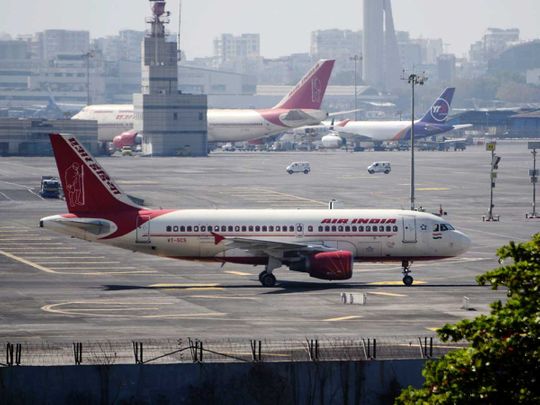
Dubai: Air India’s management has come up with a blueprint to revive the flag-carrier’s fortunes – and prestige – backed by the staggering 470 new aircraft on order. The details, as provided by the CEO, could actually come up with the intended results.
There will be one early ‘casualty’ from the consolidations that the management – under Tata Group – will enforce. The ‘Vistara’ branding will be put to rest - “Vistara is a very successful airline principally operating domestically,” said Campbell Wilson, CEO and Managing Director.
"Although in recent years it expanded internationally to a full-service airline, we will integrate and subsume that into the new Air India. We will use it to accelerate and transform and improve the Air India transformation program."
“At the end of that, the future full-service airline will be called Air India.”
Vistara was a 51:49 joint venture between Tata Sons and Singapore Airlines.
Yet to get into cruise control
Since the Tata takeover from the India government, Air India’s new management’s first priority had been to be rid of the legacy problems the airline had endured through an extended rough patch. It’s not been a smooth transition, with passengers facing the odd issue, fines being issued by the India aviation industry regulator, and complaints about the onboard food from one of India’s celebrity chefs.
Long-haul is where Air India needs to be
Financially, for Air India to get back into shape after decades of sustained losses, it will need to score in the skies. This is where long-haul routes are so vital.
“While we see a domestic and regional opportunity for India, there is mostly a long-haul international opportunity, and that is where our effort is,” said Wilson.
The first of the new 470 aircraft will enter service later this year, with the bulk to arrive from mid-2025. In the interim, Air India has already started taking delivery of 11 leased B777s and 25 A320 aircraft to accelerate its fleet and network expansion.
For now, priority markets for Air India will be North America, Europe, East Asia, Australasia and Africa. “The initial aircraft that we have leased in and those that we have returned to service over the past few months, the principal deployments for those have been North America and Europe,” added Wilson.
Gulf and domestic
The narrow-body aircraft would remain in service for the domestic market given India’s market size and opportunity. “I won’t give specific numbers because one of the benefits of having a group with both a full service and a low-cost carrier, flying both domestically and internationally, is that these assets are in some respect fungible,” said Wilson. “We can deploy the assets where they get the best economic returns.
“That will evolve as the market evolves. And so I won’t commit to a particular number now.”
A ‘sizeable chunk’ of the narrow-body planes from the new fleet of 470 aircraft Air India purchased recently could service the short-haul Gulf sector.
For long-haul networks, the airline will deploy 70 wide-body aircraft out of the 470 orders to operate to international destinations from India. “A sizable number of the narrow bodies will also be operating internationally,” said Wilson. “Depending on the variant, they have a range of up to six hours.
“So they can serve much of Southeast Asia, much of the Gulf, and even Europe.”
Last month, the Tata Group-owned Air India said it would buy 220 planes from Boeing and 250 from Airbus, a record for an order made by a single carrier. Airbus will deliver 210 of its narrow-body A320 family and 40 of its A350 wide-body aircraft, generally used on longer routes. Boeing will provide 190 of its narrow-body 737 Max jets, 20 of its 787 Dreamliner and 10 777 wide-body planes.
Air India plans to fund its $70 billion order for the 470 aircraft from equity and sale-and-leasebacks. The airline is on a massive hiring spree to recruit 4,200 cabin crew and 900 pilots through 2023, and plans are underway to build a new pilot training centre.
“The airport needs to have the capacity, it needs to have the passenger experience, and it needs to have the seamless transit functionality without bottlenecks," said Campbell Wilson. "It needs to have a speed of throughput, whether in terms of physical layout in terms of the staffing, levels of service counters, and others, the deployment of technology to facilitate the passenger experience.”
No ordinary set of challenges
Helping Air India will be factors such as the travel boom set off post-Covid, and the Indian aviation market should be among the fastest growing worldwide in the short-term. A revitalised Air India - both operationally and in mindset - should under the Tatas be able to ride that wave.

But it will require a lot of work - and goodwill. As the airline seeks to expand its presence in international markets rapidly, it faces many challenges, including operational overhauls, dealing with years of under-investment, and stiff competition from Gulf carriers such as Emirates, Etihad and Qatar Airways.
Emirates is the largest foreign airline for outbound and inbound international traffic to and from India, according to the Directorate-General of Civil Aviation (DGCA) data in India. Operating 334 weekly flights between Dubai and India, Emirates carried 4.45 million passengers between the two destinations last year.
Wilson responded, “Rather than talk about competing, let’s look at the opportunity. If you look at the size of the Indian population, favourable demography, economic growth, and the size of the diaspora of 37 million people, who are often the wealthiest diaspora of any country in which they reside. These people want to fly non-stop point-to-point.
“With our growth plans and with our intention to operate not just from one hub in India, but multiple hubs, we will be able to serve more people with the product they have all been wanting but not getting.”










